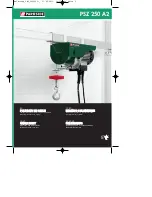
30
Installation
Installation
31
Version 1.0
| 31 |
| 30 |
Version 1.0
Handling Precautions
ALWAYS:
NEVER:
•
Keep hoist in good condition and make sure chain is lubricated and free to operate.
•
Make sure electrical connection is grounded.
•
Make smooth movements; avoid sudden changes of directions.
•
Check functions of hoist and trolley without any load before operation.
•
De-energize equipment after using it to avoid unintentional operation.
•
Keep everyone a distance of at least 1.5 times the length of chain. If load falls it can cause serious injuries and
death.
•
Make sure no one is beneath load.
•
Use pulleys or other accessories that are not specifically approved for relevant hoist model.
•
Hoist load with tip of hook.
•
Hoist load which is not vertical to hook.
•
Use hoist to pull or drag load.
•
Exceed maximum capacity of hoist.
Recommended Operation
1.
Press button lowering unloaded hook down until limit spring touches limit switch. Be sure hoist stops auto-
matically before totally compressing spring.
2.
Press button hoisting unloaded hook up until limit spring touches limit switch. Be sure hoist stops auto-
matically before totally compressing spring.
3.
Test correct function of emergency stop button. When pressing button , press emergency stop button.
Ensure hoist stops immediately after pressing emergency stop switch. Hoist should not start again if any other
movement button is activated.
4.
Rotate emergency stop switch clockwise to original position. When it bounces back, hoist can be started again.
If any of the above tests fail, unit must remain out of service, lockout/tagout power and request maintenance autho-
rized personnel to check circuit layout for automatic locking emergency stop switch.
5.
Check lubricating condition of load chain (load chain has been lubricated before delivery, but could be dried in
transportation). Apply lubricant into chain bag to protect load chain.
6.
6. Check direction of chain eyes. All welding points should be same direction. Hoist cannot be operated prop-
erly unless all welding chain eyes are in same line.
•
Position hoist in vertical position to load. Before moving trolley, make sure path of hook is free from any
obstacle.
•
Lower hook near master link to hoist load and make final adjustments to secure a 90º vertical lift operation
without any lateral deviation. Improper life angle may cause swinging of load.
•
Attach hook to load link and make sure there are no people in working area. Check that no loose items can
fall from load.
•
Begin by hoisting load two inches and stop. Check brakes are fully operational and load doesn’t lower while
stopped. Also check load is balanced and secured. Load may have changed shape or center of gravity when
suspended.
•
To reach a desired position, movements must be smooth and continuous. Repeatedly pressing buttons may
heat up motor and damage equipment.
•
Avoid sudden directions changes. These movements may damage equipment, prematurely wear down
brakes and cause accidents.
7.
Avoid any obstacle when hoisting or traveling load.
8.
Start movement of trolley and check there is no swinging of load and no obstacles in path. Stop movement
and make necessary adjustments if one of these conditions is present.
9.
Once desired position is reached, slowly stop trolley. Position load completely vertical to desired spot
where load will be lowered.
10.
Gradually lower load until it is secured on resting surface. Avoid hitting surface at high speed. If necessary,
stop movement before reaching surface and gradually lower to land load.
If hoist model has double dual/speed capabilities, always start with slower speed to avoid sud-
den accelerations. Decelerate before completing a stop.
WARNING:
NEVER leave load suspended without attention of the hoist operator!
DANGER:
ELECTRICAL AND VOLTAGE SELECTION
Available voltages 3 phase 220V 60HZ , 380V 50HZ and 440V 60HZ
Before switching voltage!




































